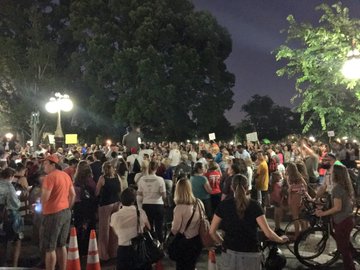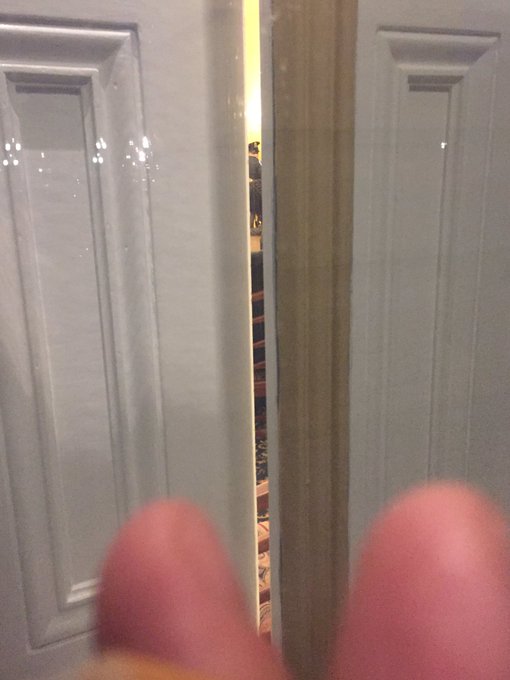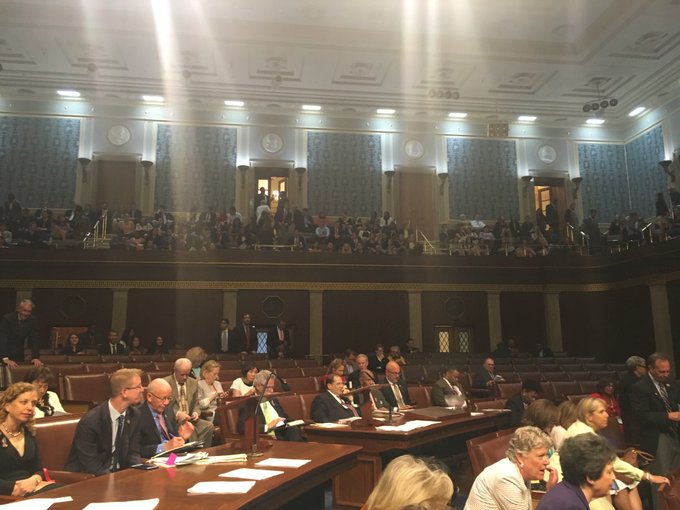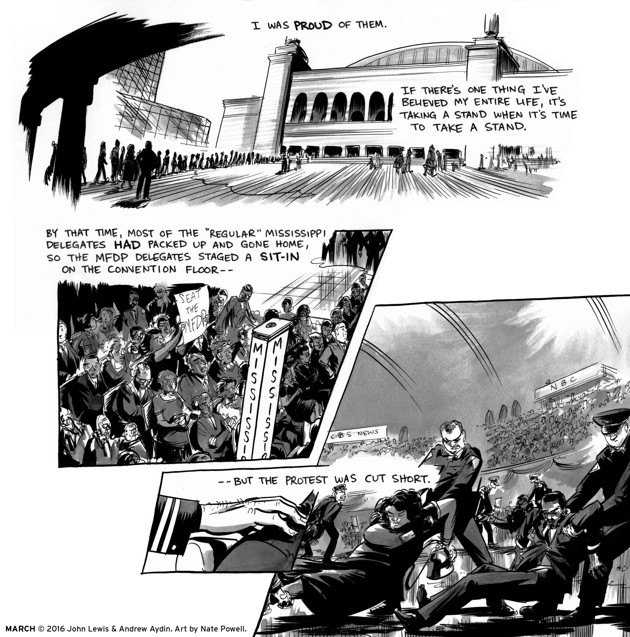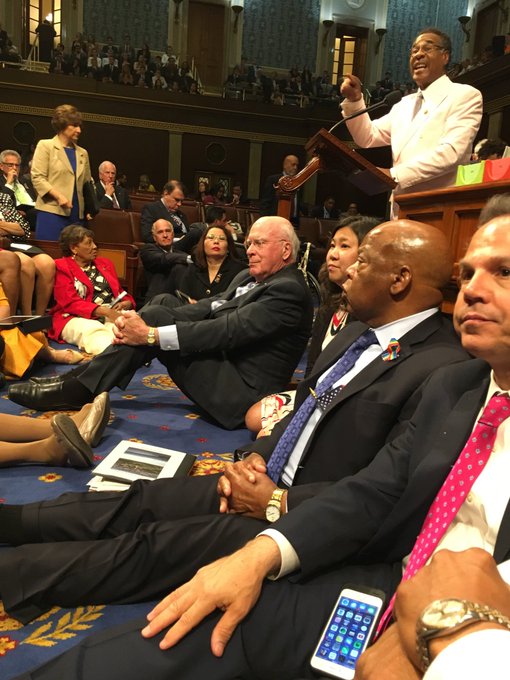In the News
A Sit-In on the House Floor Over Gun Control
June 21, 2016
Congressional Democrats, led by Representative John Lewis, are protesting the House’s refusal to vote on gun-control measures. We’re providing live updates of their protest, and reactions, as it continues.
As the sit-in hits the 24-hour mark, we’re shifting our continuing coverage to a new post. Scroll down below to see how the action unfolded on Wednesday, or follow along with us as we continue to update the story in real time here:
Democrats have been sitting on the floor of the House for 24 hours as they try to convince the Republican House majority to hold votes on gun-control measures. And it doesn’t sound like they’ll be leaving anytime soon. “We are going to hold the floor of the House of Representatives … until we can get the majority to do their jobs and give us a vote,” Florida Representative and Democratic National Committee Chair Debbie Wasserman Schultz said Thursday morning on CBS. “It is a cowardly act that they have not at least allowed a vote.”
The House, it turns out, can bring timely, controversial legislation to a vote—just not the bills that Democrats had hoped would make it to the floor.
Shortly after 3 a.m. on Thursday morning, Speaker Paul Ryan pushed a bill to fund the fight against the Zika virus to a vote, The Hill reports. It was an unusual procedure—appropriations bills are rarely rushed through to a floor vote without debate. As Nora wrote, it represents a compromise—but a deal struck among contending Republican factions, and which includes provisions that seem sure to leave many Democrats dissatisfied, and which includes crucial differences with the Senate’s measure, although it provides the same top line amount. The White House has already signaled its discontent.
A Ryan spokeswoman, AshLee Strong, explained the logic of the move:
Despite the publicity stunt on the floor, House Republicans were intent on not allowing these tactics to stop us from completing this important business. With that tangible accomplishment, we will be moving on to the previously scheduled district work period.
That’s legislator-speak for “recess time.” The chamber will rehearse the kabuki theater of the pro forma session at 9 a.m. on Thursday, but isn’t scheduled to take another vote until July 5.
For Ryan, it means making the best of a tough situation. The Democratic sit-in may have eclipsed his rollout of a concrete legislative agenda, but by reacting with a measure of restraint and stressing his desire to keep working, he’s adroitly avoided the sort of dramatic confrontation that might have proved politically disastrous.
House Democrats, a couple dozen of whom remained on the floor through the night, will reportedly meet this morning to decide on their next steps.
And just like that, the brief House session is over. Republicans gaveled the chamber back out of session shortly after 10:30 p.m. following a pair of votes unrelated to the Democrats' protest over inaction on gun control measures, which passed the 11-hour mark. (The House failed to override President Obama's veto of the resolution blocking a financial regulation.) For now, however, Democrats are continuing their sit-in in the well of the House chamber. A Periscope video broadcast on CSPAN and taken by Representative Scott Peters showed a group of Democrats giving speeches once again with the official cameras and the microphones off.
Meanwhile, outside of the Capitol, hundreds of people are gathering:
The choice of the votes the Republicans are holding is significant here. It is a procedural vote that will lead into a veto override of a joint resolution to block an Obama administration regulation on retirement savings. Democrats have the votes to sustain the veto, so this discourages them from abstaining to continue their protest. They are casting votes now, though in a slower, manual way to slow down the vote. Had Republicans chosen to bring up a normal piece of legislation that would pass by simple majority, Democrats might have chosen not to vote. It appears they will still continue their sit-in once these votes are done.
It’s a surreal scene on the House floor, as Speaker Paul Ryan gavels it back to order, and the CSPAN cameras switch back on.
The Democrats wave signs, chanting “No Bill, No Break.” Ryan bulldozes ahead, moving through the ritualized process of bringing a bill to a vote. The polite fictions of regular order are on clear display as he calls for a voice vote and solemnly intones, “In the opinion of the chair, the ayes have it,” almost drowned out by the shouted objections of Democrats on the floor.
The vote is on the repeal of the Department of Labor’s fiduciary rule, which requires investment advisors to serve the best interests of their clients—and not their own. Republicans object that the rule is a classic act of government overreach, strangling small businesses with unnecessary regulations.
It’s an important battle, but like the Democratic sit-in, it’s an act of pure political theater. There’s no indication that Republicans possess the votes to override Obama’s veto. But Ryan offers a convincing performance, remaining calm and avoiding open conflict. Now, as the House votes, the political drama takes its intermission. We’ll see who prevails in the next act.
House Speaker Paul Ryan is conducting his business like nothing is happening. Over the shouts of the Democratic members, Ryan calmly called for comment on the planned item, the override of President’s Obama’s veto of a House action to defang new Labor Department regulations over financial advisors. They’re now in the midst of a 15 minute electronic vote—and the Democrats are still on their feet.
Assuming the chair, House Speaker Paul Ryan said he appreciates that lawmakers have differences. “But the chair would hope that the business of the House could be conducted” in a way “that reflects positively on the dignity and decorum of this institution to which we all belong.” Democrats keep yelling “No bill, no break!"
It looks the showdown between House Republicans and Democrats will indeed be starting soon.
Republicans might already be in the chamber, but Democrats haven't stopped talking these last few minutes.
House Republicans are planning to hold a vote in a few minutes, but don't expect Democrats to move. “They can conduct a vote on the veto override, but that doesn't mean that we leave the floor,” Maryland Representative Chris Van Hollen said in a call from the House Democratic cloakroom, just off the floor. He emphasized lawmakers' intent to stay put, through the night if need be, and said House Republicans must agree to two votes: one on a bill to restrict suspected terrorists' access to guns, and another on background checks. “The American public would like to see democracy work its will in the House,” Van Hollen said. Votes should be held “in the light of day” and “with the microphones on.”
In 1960, John Lewis took part in a campaign to integrate lunch counters in Nashville, Tennessee, using a series of sit-ins. The first demonstrations brought torrents of abuse, but no response to the city. But then a sit-in at six stores across Nashville brought out the police force, and the arrests of the protestors. For the civil-rights movement, though, it wasn’t a defeat—but a crucial victory. So many were arrested that the jails couldn’t hold them, and they were soon released. “We were exultant,” Lewis later wrote:
Those six hours had been an act of baptism for all involved. We felt as if we’d won a huge victory. We felt that way the next day when we saw newspapers trumpeting the violence and arrests with huge headlines.
This was the lesson of the sit-in campaign—that acts of civil disobedience could advance a cause by provoking gross overreactions, and arousing the sympathy of a watching nation. And it’s one that Lewis clearly seeks to apply tonight.
That presents Speaker Paul Ryan with a difficult choice. His carefully orchestrated roll-out of a comprehensive legislative agenda is being drowned out by the Democrats on the House floor. He can continue to mount a principled case against the Democratic bill—and on the no-fly list, in particular, he’ll find plenty of liberals who share his concerns about singling out Americans without due process of law. But that won’t move the Democrats off the floor.
Alternatively, he can instruct the sergeant-at-arms to have the Capitol Police clear the floor. As Nora noted, there are reports that officers are standing by—and that the House will move to a vote at 10 p.m. Earlier this afternoon, Representative Charlie Dent, a close ally of Ryan’s, hinted at what might be ahead. “It will be loud and probably be noisy,” he told The Hill. “You might want to get in the gallery and watch the show.”
It’s hard to imagine, though, that the sight of John Lewis once more being dragged away by police officers, splashed across front pages across the country, will yield the results that Ryan seeks.
House Republicans will reconvene at 10 p.m. to vote on legislation, according to House Majority Leader Kevin McCarthy’s communications director.
H.J. Res. 88 is unrelated to the sit-in. The bill is regarding the Labor Department’s fiduciary rule. House Republicans were originally scheduled to vote on a veto override of the rule earlier tonight, before that vote was delayed by the House Democrats' sit-in.
Reports on Twitter suggest that a group of law enforcement officers are idling in the Capitol building. While officers consistently provide security in buildings on the Hill, it seems many are assembled in just one room on the first floor, the one below House chambers.
North Carolina Democrat G.K. Butterfield just called for Speaker Ryan to come to the House floor. He first arrived in House chambers more than eight hours ago, and thinks “it’s going to be a long night” for House Democrats.
Even if phones aren’t permitted on the House floor, they’re certainly in full use today. So much so that there’s a call on the floor for phone batteries:
As Nora noted earlier, CSPAN hasn’t been able to stream the House sit-in due, in part, to tensions between the network and House leadership. As a result, a number of members have had to live stream it on their own devices. But they’ll have to charge up to keep them going.
The rule against mobile phones on the House floor isn’t even as old as mobile phones. A version first came into effect in 1995 as a ban on “personal electronic office equipment.” In 2003, it was modified to bar the use of “a wireless telephone or personal computer” on the floor. It assumed its present form in 2011, as a ban on “any mobile electronic device that impairs decorum.”
But what does that mean? The body’s parliamentarian explains:
Pursuant to the modification of this clause in the 112th Congress, the Speaker announced that mobile electronic devices that impair decorum include wireless telephones and personal computers, but that electronic tablet devices may be used unobtrusively in the Chamber, although no device may be used for still photography or for audio or video recording (Speaker Boehner, Jan. 5, 2011, p. l). The Chair has also announced that Members should disable wireless telephones on entering the Chamber (e.g., June 12, 2000, p. 10369).
So tablets are allowed on the floor, but even having phones switched on, much less snapping photos, tweeting updates, or periscoping the proceedings, is a violation of the rules of the House.
It may be the least of the acts of civil disobedience on display today. But like other acts in defiance of formal rules and established norms, it’s likely to have ripple effects that extend beyond this particular protest. Now that members have seen how effective a tactic live streaming can be, expect to see it deployed in support of initiatives of all kinds.
John Lewis is rallying the troops before the Republicans enter the chamber. “I want to thank each and every one of you for finding a way to get in the way,” he told his fellow Democrats. “We have a right to protest for what is right. This may be the floor of the House, but this is the people's house. They sent us here to represent them. That's all we can do.”
His gave some counsel to legislators unused to a sit-in, especially one that will soon be surrounded by determined members of the opposite party. “My advice would be to be orderly, be peaceful, and respectful … I don't know what's going to happen tonight. But my idea is, just stay here.”
House Republicans will apparently try to hold a vote tonight, despite the seated Democrats, to overturn a Labor Department regulation on financial advisors.
From The Hill:
"It will be loud and probably be noisy,” Rep. Charlie Dent (R-Pa.), part of Speaker Paul Ryan’s group of advisers, told reporters after House Republicans held a special meeting about how they should respond to the day-long Democratic sit-in. “You might want to get in the gallery and watch the show,” Dent added.
The Democrats say they’re not moving; from CSPAN’s livefeed, it appears they’re amping up for a bit of a fight. If the Republicans want to take a vote, they’ll "need a crane” to clear the chamber, one member joked.
Democrats have been occupying the House floor for almost eight hours. In that time, as we’ve already noted, CSPAN’s cameras have been turned off. Politico noted earlier today that the cameras are cut off because the House is not in session. But Democrats, including Hillary Clinton, have suggested Republicans are deliberately trying to hide their sit-in from the American people. In his interview with CNN, Paul Ryan said that’s not true. “This is the way the rules work,” Ryan said, “and this is how they have [worked] ever since we’ve had TV.” Ryan noted that Democrats turned off the cameras in 2008 when House Republicans staged a similar protest, an incident my colleague Russell Berman wrote about earlier this afternoon.
The Hill has more on the longtime tension between CSPAN and House leadership:
The incident highlights a major conflict between C-SPAN—the network that has provided floor coverage for decades—and the House administration, which controls the video, audio and angles of the cameras.
The feed itself is produced by the House recording studio, which is under the control of the House majority leadership.
Since 1979, the cable network has had to rely entirely on the House feed for its coverage. The company has made numerous requests to both parties over the years to set up its own cameras, which have been denied.
"We have a long history of asking for access and being denied by both parties over the years," C-SPAN Communications Director Howard Mortman said.
He said it is common for the cameras to go off when the chamber is in recess, though that did not stop viewers from expressing their outrage.
Democratic Representative John Lewis, the elder statesman behind the sit-in, just sent an email blast asking for petition signatures to put pressure on Paul Ryan.
(Recipient’s name), I’ve had enough. Enough of my Republican colleagues’ inaction. Enough of the empty thoughts and moments of silence. Enough of the daily toll of gun violence in this country. It is time that Congress do what is just, what is right, and what is long overdue. But House Republicans won’t consider any action on gun safety. That’s why I, and many House Democrats in Congress, began a sit-in on the House floor just hours ago. Join us in fighting for common-sense gun safety. How many more people need to shed tears of grief, before we do something? Republicans cannot continue to stick their heads in the sand and ignore the plague of gun violence in our country. The American people are demanding action and we have the obligation to do what we can to reduce gun violence in our great nation. The time for silence is over. Stand with us: Add your name now. Thank you, John Lewis
The email links to a Democratic Congressional Campaign Committee petition featuring a rather unflattering photo of Ryan, and requests an email address and a zip code. As of 7 p.m., it appeared the petition had close to 900,000 signatures, though the site only shows an overall progress bar and not individual responses.
Word has it that House Republicans met at 6 p.m., either to discuss the Democratic sit-in or to figure out what the heck they're going to do the rest of this week. Earlier on CNN, as Nora notes, Paul Ryan broke his day-long silence on the Democratic takeover, calling it a "publicity stunt."
But looking at Twitter, you wouldn't think Republican members of Congress had noticed at all. This GOP-curated list of official House Republican Twitter accounts is almost entirely devoid of any mention of the sit-in, instead hyping Ryan's health care speech. Compare that to the Democratic feed, which is packed wall-to-wall with Tweets of support for #NoBillNoBreak.
But did I speak too soon? Two Republicans just dropped tweets deriding their Democratic colleagues:
Is this the beginning of a deluge?
Paul Ryan never gets to talk about what he wants to talk about. In a CNN interview Wednesday—the same day House Republicans released their new health-care plan—Wolf Blitzer peppered Ryan with questions about the sit-in happening in his House chamber. “This is a publicity stunt,” Ryan said, when Blitzer asked if he would schedule a vote on a terrorist-watchlist-related bill. “They are trying to get you to ask me those questions for publicity’s sake.”
Ryan is used to having his policy agenda sidelined since becoming House speaker last fall. For months, his press conferences have been hijacked by questions about Donald Trump, who was also the subject of much inquiry in the CNN interview. Gun control dominated the first part of Ryan’s interview Wednesday, with Blitzer asking Ryan directly whether the National Rifle Association—which Blitzer said has contributed tens of thousands to Ryan—is blocking action in Congress. “No, the Constitution is,” Ryan said, adding that people have a right to own guns.
New Jersey Senator Cory Booker joined House Democrats on the floor earlier this afternoon, and if they’re still there later tonight after he attends an event, he plans to go back. House Democrats supported the Senate’s gun-control filibuster last week, and Booker intends to return the favor.
“We’re at a point now where the crisis before us—I think—necessitates us using our moral imagination in finding new ways” to come together on gun control, Booker told me. In his view, John Lewis’s role in the sit-in is of the utmost significance, and could bring outsized attention to Democrats’ efforts. He said a compromise in the Senate on gun control is an “impressive change” for that chamber, and “hope[s] you’ll see in the House some of the same movement you’re seeing in the Senate.”
“I can only hope that a moral giant like John Lewis, the activism of other members, the engagement of the American public as a whole, call to the conscientiousness of those who are resisting common-sense steps,” Booker said.
Harry Reid lent his support today to Senator Susan Collins's gun control compromise bill, saying that while it may be a small step, “at least it is a step forward.”
“I support Senator Collins’ legislation to keep guns and explosives out of the hands of terrorists,” the Senate minority leader said in a statement. “Democrats and Republicans are working together to find solutions and protect Americans from gun violence. The Senate should vote on Senator Collins’ amendment.”
Reid's support will lend momentum to a bill that hasn't yet completely won over Senate Democrats, including No. 3 Chuck Schumer, who has pushed for wider reform. Senate Majority Leader Mitch McConnell has promised to give the bill a vote but has yet to reveal his own position.
Members have applauded the spontaneous nature of today’s events, but behind the scenes, plans for the sit-in have been brewing for several days. Massachusetts Democrat Katherine Clark told me it all started last week on the House floor, when she approached Representative John Lewis. She told him her concerns that Congress would not act on gun control in the wake of the Orlando shooting, and Lewis suggested they make a “dramatic” move—and stage a sit-in. Clark and Lewis formulated their plan over the weekend—with some other members joining in—but they mostly tried to keep it “somewhat under wraps.” By Tuesday morning, lawmakers had prepared a letter to send to House Speaker Paul Ryan, and word about their effort began to spread. The Ryan letter, with 19 total signatories, describes what they had planned for the floor:
[W]e stand with thousands of brokenhearted families who have not been served by this Congress, and millions more who are counting on us to find the moral courage to do the right thing. We stand together in our refusal to sit by while this Congress abdicates its fundamental responsibility to protect American families from harm. We urge you to keep the House in session until we have robust debate and votes on expanding background checks and banning the sale of firearms to suspected terrorists.
Until then, we are resolved and committed to speaking out for victims, survivors, and families at home who deserve a vote. We are prepared to continue standing on the House floor whenever the House is in session to assist you in bringing these bills to a vote.
Clark said the response to the sit-in—seeing the ranks of lawmakers on the floor grow, and the normally empty gallery fill up—has been heartening. “It has been a very emotional and powerful day,” Clark said, noting that she’s listened to her colleagues “talk from their hearts about their experiences in their districts and their neighborhoods with gun violence, and [about] how what we’re asking for is so simple.” She said she’s hopeful they’ll get news from GOP leadership about scheduling a vote. But if that doesn’t happen, Clark is prepared to stay: Before she came to the Hill this morning, she packed a suitcase, toothbrush, and “as many phone chargers as I could.”
Will House Democrats get a vote on the gun control measures they're hoping for?
House Democratic Whip Steny Hoyer told reporters that he spoke with Republican House Majority Leader Kevin McCarthy, but said McCarthy didn’t seem willing to negotiate. “The majority leader came over and talked to me, and we simply talked about what I thought was needed to get on with the business that they want to pursue,” Hoyer said. “I said, ‘well, very simple, just give us a vote.’” Asked what the majority leader said in response, Hoyer said: “He didn’t give us a vote, yet.” McCarthy also didn’t give any indication that he would negotiate, according to Hoyer. He added: “I made it pretty clear that what members wanted was to have the opportunity to vote, and that I would think his members would be amenable to voting, and he ought to be amenable to voting.”
Are House Democrats planning to hold the floor until a vote is allowed? “I think we’re intending to hold the floor for a long time,” Hoyer said. That doesn’t mean a vote will actually happen. “I don’t know that I’m optimistic, I’m hopeful,” he said. The majority leader’s office did not immediately return a request for comment. This post will be updated if they respond.
The Boston Globe’s Matt Viser notes on Twitter that House Speaker Paul Ryan, who has not yet made public remarks on the sit-in, will appear on TV in just over an hour.
Viser is surely right—no reporter could resist asking Ryan what he makes of the House chamber takeover. But whether Ryan's new health-care plan gets much airtime at all is another matter.
Senator Bernie Sanders has made his way to the House floor to participate in the Democrats' sit-in. It is unclear if he will give remarks—or even what the proper procedure is for such remarks, but his presence is already important as the presidential candidate has been hammered by Hillary Clinton and others in the party for his stance on gun control. He has recently supported the proposed background check legislation and rule banning people on the terrorist watch list from buying guns.
At least one House Republican seems to think the sit-in is a distraction. Republican Representative Jeff Duncan, of South Carolina, took to Twitter to offer a theory as to why Democrats are holding the House floor.
Though their individual agendas may differ, most Democratic participants in this sit-in want the same thing: legislative movement on gun control proposals, which are largely jammed up in the Senate. Several bills seek to deny firearms to people listed on a government-maintained terrorist watch list, including the “no-fly” list. The most recent proposal came from Senator Susan Collins of Maine, whose legislation would make it harder for folks with suspected terrorist ties to purchase a gun, and would require to FBI to send up a red flag if someone listed in a broader terrorist watch list bought a weapon.
But as my colleague Conor Friedersdorf recently noted, this approach has serious civil rights implications, even though most Americans say they'd support such a move. Denying a person their constitutional rights based on their inclusion in a dicey government-run database is troubling, he said:
America’s terrorist watch list is an opaque abomination. Members of the public are unaware of what actions might get them placed on the list. Individuals cannot verify whether or not they've been designated by their government as an enemy. They can't challenge their status before a neutral arbiter, or know when their status changes. The Obama administration has run a system in which watch-list standards are beyond debate, and in which individual determinations are made entirely within the executive branch, short-circuiting the American system of checks and balances. This degree of secrecy and arbitrariness is un-American, and may even prevent scrutiny of why this latest terrorist was erroneously excluded as a threat.
It is already a scandal that a list like this can prevent a person from flying, as if moving about the country is a privilege, not a right. And now, Democrats are proposing that being on a secret, due-process free list should strip people of a constitutional right.
It's not clear whether the measures Collins supports would have kept Omar Mateen from obtaining a gun. Though investigated by the FBI and briefly included on a broader terror watch list, Mateen was no longer being monitored when he made his purchase. Indeed, as Russell noted last week, Mateen was working as a licensed security guard at the time. Collins's “look-back” provision might have alerted the FBI that he had his hands on an assault rifle, but unless they reached him within a week of the purchase, it would have been too late.
While I'm not opposed on civil liberties grounds to bans on high-capacity magazines or other gun control measures that preserve the individual right to own a weapon, I'm highly skeptical of efforts toward even those ends that feature members of Congress adopting the tactics of the powerless. Sit-ins are righteous when they're the tool of an oppressed minority group insisting on equal rights. And the tactic is at least defensible when it's the only way to draw attention to an ostensibly righteous cause no one would otherwise know about or have a chance to rally behind.
But members of Congress are among the most powerful political actors in the country, and they are acting on an issue that is endlessly discussed and debated, not one that requires unusual tactics, like subverting order in the national legislature, to air all sides of the matter. When Republicans respond to not getting their way by undermining legislative norms, the press objects.
It should object here.
Legislators who lack the votes to do what they want have the platform to persuade the public and to campaign to oust their colleagues. Precisely because of their political power, their extra-political machinations have less legitimacy. And they are likely to fail, because they do nothing to change the underlying obstacles to more gun control: the Constitution, a determined minority interest group that cares about the issue more than its opponents, and voters who, while well to the left of the NRA, are well to the right of congressional Democrats on guns.
Republicans may have shut off the cameras and the microphones in the House, but at least they haven’t shut off the lights. Eight years ago, it was Republicans doing the protesting on the House floor, and then-Speaker Nancy Pelosi who was shutting them down. That demonstration was over the refusal of Democrats to hold a vote on energy legislation, which I wrote about here.
Tom Cole, a Republican representative from Oklahoma, expressed frustration over the sit-in. “It's disappointing,” he said while stepping into an elevator outside the House gallery.
Asked if he had a sense of what Republicans plan to do in response, Cole replied: “I don't know what the plans are, but I don't think we should allow any group to bring the work of the House to a halt.” For now, House Republicans may not have a concrete plan, but they seem to steering clear of the House gallery and surrounding area.
Floridian Debbie Wasserman Schultz read a letter from former Arizona Representative Gabby Giffords to her fellow Democrats. As I mentioned earlier, Giffords was shot in 2011 and has been a powerful symbol for the gun-control movement ever since. She and her husband Mark Kelly, a former astronaut, started their own advocacy group, Americans for Responsible Solutions, in 2013. Its founding coincided with the second anniversary of the Tucson shooting in which Giffords was wounded, just weeks after the Newtown massacre.
In her letter, Giffords emphasized that gun violence affects a wide variety of people and communities. “They die by murder, they die by suicide, and they die by neglect,” she wrote. “Often, they don’t die, but they carry the scars and their lives change forever.” She wrote there is “nowhere that I would rather be” than the House floor, and called on members of Congress to put aside their differences and move forward on gun-control measures. “Speaking is difficult for me, but I haven’t been silenced,” Giffords wrote, her words moving Schultz to tears. “And neither should the American people. Their representatives must vote to prevent gun violence.”
Elizabeth Warren is in the House.
The senator from Massachusetts is hitting the campaign trail for Hillary Clinton this month, starting in Cincinnati on Monday. Warren was one of the last Democratic senators to endorse Clinton, and is reportedly being considered as her potential running mate.
Congressman Beto O'Rourke of Texas has begun streaming the sit-in on Facebook, giving people outside of the chamber another way to tune in as the House's televisions, which are controlled by Republican Party leaders, remain turned off. It looks like Facebook does not allow users to embed videos while they're still live, so go here to watch.
This sit-in is about to enter its fifth hour. Members are supposed to be voting today, but it's not clear if and when those votes will happen. According to a floor schedule circulated by Democratic Whip Steny Hoyer before the sit-in started, the first vote was expected between 3 p.m. ET and 4 p.m. ET.
Debbie Stabenow and Ron Wyden are two of the Democratic senators who made the trek over to the other side of the Capitol to show support for the sit-in. “I really appreciate their [House Democrats] courage in joining with what we started in the Senate,” Stabenow said, alluding to the recent filibuster that took place in the upper chamber.
“Thoughts and prayers are not enough. We need action,” she said, adding: “The people of the country deserve a vote. Right now the House Republicans are blocking even a vote. There is carnage in our country.” Wyden echoed her remarks, saying: “These mass shootings are happening like clockwork.”
Stabenow said that Senate Democrats did not know about the action ahead of time, but “we immediately got involved to support them.”
Speaker Paul Ryan has been tweeting—but not about the open revolt on the House floor. Instead, he's promoting a speech he just gave at the American Enterprise Institute on a proposed replacement for the Affordable Care Act. It's led to an interesting string of replies on his Twitter feed.
Gabby Giffords, the former Arizona House member, has evidently prepared a letter for House Democrats. Giffords was shot in 2011 while meeting with constituents, and has been a prominent advocate for gun control ever since. Minority Leader Nancy Pelosi said moments ago that she wants to read the letter, but won’t do so while the mics are off. She called on House Speaker Ryan to act: “Mr. Speaker, turn on this microphone.”
Periscope is catching on to the high demand, and has created a channel for footage coming out of the House floor:
Democrats seem to be reveling in their rule-breaking. To claps and cheers, Representative Jared Huffman noted moments ago that while CSPAN’s House cameras aren’t on, “far more people” are watching the floor on “pirated” video than would normally be watching CSPAN. Referring to his Republican colleagues, Huffman said “they can cut off the mics, they can cut off the cameras, they will not silence our voice.”
Representative Scott Peters, whose Periscope stream CSPAN is carrying, just recommended that his fellow members download Periscope and stream the floor with him.
U.S. Representative Emanuel Cleaver, of Missouri, referenced the widespread support among the American public for new gun laws on the House floor. “Ninety percent of Americans are with us,” he told his colleagues. “Ninety percent of Republicans say that we ought to restrict guns so that people on terrorist lists can't get guns. Everybody's for this.” He scoffed. “We can't get the mics on.”
Cleaver didn't cite his source. But a recent survey by CNN/ORC mostly backs up his assertions. Around 85 percent of respondents said they'd support preventing people on the no-fly list from owning guns. (Republicans were actually more likely than Democrats to agree with this measure, at 90 percent versus 85 percent). More than half of Americans favor a ban on the manufacture, sale and possession of semi-automatic rifles, and an identical proportion support banning high-capacity ammo clips.
That said, support for these measures have generally slipped over the past five years. The percentage of people who support an assault rifle ban, for instance, fell 7 percentage points since January 2011, from 61 percent to 54 percent.
Alan Grayson, a Democrat from Florida, has begun reading the names and ages of the 49 victims of the Orlando shooting. The city of Orlando has a list of the names on its website here. Most of the shooting victims were men in their 20s and 30s; the youngest was 19, the oldest was 50.
Alan Grayson is optimistic. “They [Republicans] haven't even attempted to take the floor from us, so that's encouraging,” the Democratic representative from Florida told me outside the House gallery. “Maybe that means they're trying to decide ... what they can do to acknowledge people's understandable feelings that action is necessary right now.”
Grayson wants a vote on gun control measures, but “more than just a vote, I'm hoping that we actually pass solid gun safety legislation,” he said, adding: “but obviously without a vote we couldn't possibly do that.”
The congressman said he's never seen anything like this before. “It's heartfelt,” he said. “We are showing up, and standing up in any way that we can to save people's lives.”
This sit-in is a return to old habits for its leader Representative John Lewis, who is well-known for his history as an activist in the Civil Rights Movement with the Student Nonviolent Coordinating Committee (SNCC). He has experience with dozens of protests, sit-ins, and the famous Freedom Rides.
With the Republican and Democratic conventions on the horizon and with black protest perhaps brewing again, the sit-in on the House floor for gun legislation is a reminder of Lewis’s involvement in the 1964 Democratic National Convention in Atlantic City, where his “Freedom Summer” ended with a powerful speech from Fannie Lou Hamer and a sit-in from the black Mississippi Freedom Democratic Party in favor of a voting rights law. That sit-in precipitated a massive change in American electoral politics and was a key contributor to the passage of the Voting Rights Act of 1965.
The third volume of Lewis’s graphic novel series, March: Book Three, created by Lewis himself along with Andrew Aydin and Nate Powell takes a look at the 1964 Democratic Convention, and the parallels to the current moment and the tension around the 2016 Cleveland and Philadelphia conventions are striking:
March: Book Three comes out August 2 and I think it’s a great companion for understanding Lewis and his choice of action on the floor today. Here’s a look at the cover too:
According to Virginia Democrat Gerry Connolly, the sit-in “didn’t start as some organized plan.” He called me after making remarks on the floor about the 2007 Virginia Tech shooting, when “my community, Fairfax County, buried five young people.” More than 30 people died in that incident. “Unfortunately this is being repeated all over the country,” he said. Connolly said the sit-in happened “almost spontaneously,” and has taken on a life of its own. In his view, the ad-hoc nature of the protest reflects members’ feeling that “enough was enough”—they had just “had it.”
Senator Patrick Leahy of Vermont has taken a seat on the House floor.
Other senators present, according to Twitter reports: Chris Coons, Chuck Schumer, Ben Cardin, Barbara Boxer, Ed Markey, and Claire McCaskill.
Even though many Democrats are participating in today's sit-in, this isn't necessarily a unified push within the party. Many on the left do not agree with the current proposal to ban gun sales to those on two separate terrorist watch lists. As the ACLU wrote in a letter to legislators earlier this week:
Our nation’s watchlisting system is error-prone and unreliable because it uses vague and overbroad criteria and secret evidence to place individuals on blacklists without a meaningful process to correct government error and clear their names.
One piece of evidence: John Lewis, who is leading the charge in the House, spent months being stopped by authorities at airports.
Speaking to reporters and a crowd of onlookers gathered outside the U.S. Capitol, Democratic House Minority Leader Nancy Pelosi said: “Members, they have just had it.” When asked to comment on the significance of the event, Pelosi replied: “What's important about this moment is the spontaneity of it all on the part of each and every member.” She added: “All of them want to be a part of the echo chamber against gun violence in our country.”
More Senate Democrats are joining their House colleagues on the floor, according to reports on Twitter.
Meanwhile, on the Senate floor, Republicans are talking about national security as it relates to the Orlando massacre. Based on my periodic check-ins with CSPAN’s Senate stream, Democratic lawmakers there have not tried to dominate speeches with similar gun-control talk.
U.S. Representative Denny Heck, who represents Washington’s 10th District, just spoke to his colleagues from the commandeered House floor. “In the time that we’ve been here, maybe while you were sitting down, three people were shot and killed in Lacey, Washington,” he said. Lacey sits inside Heck’s district. “I’ll tell you what I’m not going to do. I’m not going to ask for a moment of silence...How numb, how inured do we have to get to this before we’re prompted to action? How used to this do we have to get?”
I'm not sure how much it falls in line with regulations, but sit-in members just held a vote to suspend the rules and thus keep phones and recording devices on through their speeches.
President Obama chimed in on Twitter, thanking Georgia Representative John Lewis, who led the sit-in on the House floor.
Democratic Whip Steny Hoyer’s office posted a video on YouTube of the moment the House went into recess, with Democrats yelling “No bill, no break!” “The chair finds that the House is currently not in a state of order, due to the presence of members in the well who are not recognized,” Republican Representative Ted Poe said. “The chair would ask members to leave the well so the House may proceed with business and decorum."
Sit-ins and protests on the floor of Congress are rare but do occur from time to time. Over the past few decades, both parties have engaged in them.
Republicans mounted a floor protest over energy legislation on August 1, 2008. After then-Speaker Nancy Pelosi adjourned the House, the bill—which would, in part, lift a federal ban on offshore oil drilling in the Arctic National Wildlife Refuge—was left without a vote.
Republicans were outraged. According to John Boehner, the minority leader at the time, around a dozen or so Republicans occupied the otherwise vacant floor to protest the decision and demand a special session for a vote. News reports indicate that they encouraged tourist to fill the galleries. One lawmaker brought a stack of gas station receipts, which he brandished above his head.
The protests continued for days. Congress would pass an energy bill later in the session. It did not include drilling rights in the refuge. “The whole floor was packed, the gallery was packed,” Boehner said. “This has never happened before.” But it had.
On November 18, 1995, in the midst of a full government shutdown over the federal budget, 28 Democrats stormed the floor after the Republican leadership refused to keep working, called a recess, and left.
The Democrats chanted “work, work, work,” “save Medicare,” and “where’s Newt?” in reference to the House Speaker Newt Gingrich. Notably, the Republicans turned off the television cameras in 1995, as well. But Harold Ford, a Democrat, climbed up to the press gallery and turned them back on.
The protesters threatened to stay all night. But two hours later they were gone. Congress passed a temporary spending bill the next day.
Nancy Pelosi and other Democratic members of Congress are holding a press conference on the steps of the Capitol. “There's no more scream than primal nor pathetic than the sound of a mom who has learned her child has been shot,” Pelosi said. Charles Rangel’s Periscope feed is streaming the speeches live.
And more on their way, Nora.
About 30 Democratic members started the sit-in more than one hour ago. Since then their numbers have grown, Scott Wong, a staff writer for The Hill, reports on Twitter:
For some perspective, that’s less than half of the 188-member-strong Democratic caucus. More members may decide to participate as the sit-in continues, or may be coming and going from the chamber.
Democrats are certainly getting attention for their sit-in, but their best legislative strategy for getting a “no-fly, no-buy” gun bill passed through the Republican-controlled House may be to wait for Senate action on Susan Collins's compromise, which Nora wrote aboutyesterday. Senate Majority Leader Mitch McConnell promised her a vote on the bipartisan amendment. Its inclusion in an appropriations bill funding the Commerce and Justice Departments could be the only realistic way to get it to President Obama’s desk. If Republicans called up a Democrat-sponsored bill in response to the sit-in today, it would likely fail.
The House sergeant-at-arms is now trying to enforce the ban on photography by asking Democrats to refrain from taking pictures or video, Representative John Yarmuth of Kentucky tweeted.
Democrats have escalated their rhetoric on gun control in recent days. On Tuesday, the White House denounced the U.S. Senate’s rejection of a series of gun proposals. “What we saw last night on the floor of the United States Senate was a shameful display of cowardice,” said White House Press Secretary Josh Earnest on MSNBC. President Obama echoed Earnest on Twitter, saying, “Gun violence requires more than moments of silence. It requires action. In failing that test, the Senate failed the American people.” On Wednesday, the White House noted its frustration again, according to the reporter Michelle Kosinski.
Hillary Clinton has weighed in on House Democrats’ protest: She’s with them.
It’s possible Clinton knew the protest was going to happen. As my colleague Priscilla Alvarez wrote earlier this morning, the presumptive Democratic nominee was scheduled to meet with the House Democratic caucus at 10 a.m.
Not that reporters will complain about transparency, but any photos—or Periscope videos— that you see Democratic lawmakers posting to social media from the House floor are against the rules, as photography is prohibited in the chamber. Members also frequently flout the ban during State of the Union addresses.
At least one Republican is backing the Democrats' push for a vote on "no fly, no buy" gun legislation: Representative David Jolly of Florida. Jolly had been running for the Senate but dropped out last week and decided to seek reelection to the House instead. He tweeted during the sit-in Wednesday afternoon that GOP leaders should put his proposal to prohibit suspected terrorists from buying guns on the floor. Jolly, of course has already lost support of GOP leaders in a fight over party fundraising.
Politico reports that Speaker Ryan’s office does not seem amenable to Democrats’ move. “The House cannot operate without members following the rules of the institution, so the House has recessed subject to the call of the chair,” Ryan’s spokeswoman, AshLee Strong, said in a statement to The Atlantic.
"What is the tipping point? Are we blind? Can we see? How many more mothers and fathers must shed tears of grief before we do something?" That’s how Representative John Lewis exhorted Congress to vote for "common sense" gun measures. His speech evokes Lewis's own history of nonviolent protest, and is a powerful reminder of what his work has accomplished. His colleague John Larson called him the "soul of America" in accompanying remarks.
C-SPAN wants its viewers to know that it does not control the TV cameras in the House chamber and cannot broadcast when the House is not in session. This is reminiscent of when Republicans staged a protest against the Democratic majority during the summer recess in 2008, speaking in a darkened chamber to demand action on energy legislation.
Senator Chris Murphy, who led the Senate filibuster on the same issue, is now on the House floor, in solidarity with his fellow Democrats. CSPAN is still not broadcasting a live feed of the chambers, but the network is replaying members’ speeches online.
John Lewis has championed nonviolent protest his entire career. As a young man, he was the chairman of the civil-rights-era Student Nonviolent Coordinating Committee, which his congressional biography notes was “largely responsible for organizing student activism … including sit-ins and other activities.” He spoke at Martin Luther King Jr.’s 1963 March on Washington, and led the Selma March two years later. On Wednesday, he said the “time for silence and patience is long gone.”




